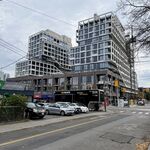http://www.thestar.com/news/gta/article/640284
Nothing it has learned from the streetcar controversies along St. Clair and Spadina Aves. has changed the TTC's resolve to operate the seven new Transit City lines on a raised 15-cm concrete bed in reserved lanes in the middle of the road.
The core philosophy of the $10-billion plan remains: Transit gets priority, the car will be pinched, and the desires of urban design buffs will be accommodated only as feasible.
"We shouldn't be spending the kind of money we are with Transit City and then be competing with traffic and left-hand turning vehicles," Gary Webster, TTC chief general manager, said yesterday.
Webster and Transit City program manager Sameh Ghaly say the reserved corridor is good for city building, good for transit and sends a powerful message to the public that the city is serious about moving commuters efficiently.
If the TTC learned anything from developing the Spadina and St. Clair streetcar lines, it is this: You can't please every interest group. There will be tradeoffs. And the sooner you outline them to the stakeholders – drivers, storefront businesses, cyclists, pedestrians and urban design buffs – the sooner reality sets in.
So, what to expect from Transit City lines, starting with Sheppard E., Finch W. and Eglinton?
Only one corridor, Sheppard E., is close to being wide enough (36 metres) to satisfy everyone by providing bike lanes, wide sidewalks, parking, two lanes of through traffic, dedicated turning lanes and the dedicated transit lanes for the entire route. Even this line has narrow segments that will mean loss of parking or bike lanes.
The Don Mills and Jane St. corridors are so narrow, planners will be challenged to find any segments able to include all the features.
Some commuters may have to walk five to 10 minutes to get to Transit City stops because they'll be farther apart than bus stops. Fewer stops mean faster travel, but less appeal for those who live midway between stops.
Along Eglinton Ave., which is too narrow in places, the problem is exacerbated. Eglinton streetcars will run underground between Leslie and Keele. Underground stops 500 metres apart and connected to street-level entrances would be too expensive, so stops here range up to a kilometre apart, akin to a subway line.
That's clearly a disincentive to use transit, so TTC is considering running a parallel, less frequent bus service here, similar to what's done currently on Yonge St.
TTC is projecting that increased reliability and predictability of service – transit arriving as advertised and reaching its destination on time – will overcome the inconvenience of stops being further apart. They should anticipate a huge pushback from commuters. Nothing rankles more than losing your stop.
Webster says reliability is the huge selling point for the reserved transit lanes of Transit City. For instance, along St. Clair, the travel saving from end to end amounts to five minutes running time. Riders travelling a much shorter distance likely save one or two minutes.
But other benefits add to the quality of the commuting experience. The wait times at Transit City stops should be reduced because the streetcars won't get held up by turning vehicles or traffic clots. Having cars evenly spaced along the route should mean less instances of overcrowding. In total, Ghaly and Webster promise that the quality of transit service will be greatly improved.
Bottom line on Transit City: Expect minor tinkering, but there's little chance of derailing the plan.





